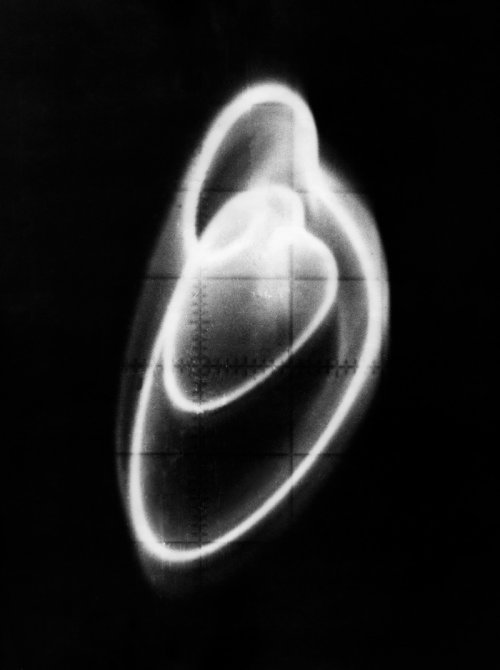Research
We concern with the class of chaotic states, which can arise in weakly nonlinear systems. We have predicted theoretically and proved experimentally that any degree of nonlinearity, however small, can initiate a chaotic behavior in physical and other systems [1, 2]. Efficient analitical numerical, and experimental methods have been proposed for the study of the conditions for, and the mechanisms of, the transition to chaos in the weakly nonlinear limit [1 -6]. These findings have been applied to the investigation of the chaos onset in various systems starting from various RF- and microwave devices [7 - 10] , SQUIDs [11], micro- and nanomechanichal systems [12] and up to motion of tectonic plates [13] and dynamics of variable stars [14].
 Fig.1 Experimental observation of a strange attractor in a weakly nonlinear circuit with quasi-periodic forcing [5]
Fig.1 Experimental observation of a strange attractor in a weakly nonlinear circuit with quasi-periodic forcing [5]
References
| 1. A.B. Belogortsev, D.M. Vavriv and O.A. Tretyakov: Destruction of quasiperiodic oscillations in weakly nonlinear systems., Appl. Mech. Rev.,, Vol. 46, #7, pp.372-384 (1993) |
| 2. D.M. Vavriv, V.B. Ryabov, S.A. Sharapov and K. Ito: Chaotic states of weakly and strongly nonlinear oscillators with quasiperiodic excitation., Physical Review E., Vol. 53, #1, pp.103-111 (1996) |
| 3. D.M. Vavriv and V.B. Ryabov: Current Lyapunov exponents and the conditions of chaos arising., Zh. Vychislit. Mat. and Mat. Fiz., Vol. 32, #9, pp.1409-1421 (1992) (in Russian) |
| 4. G.D. Grischenko and D.M. Vavriv: Chaotic states of a pendulum with a quasiperiodic forcing., Zh. Tekh. Fiz., Vol. 67, #10, pp.1-10 (1997) (in Russian) |
| 5. D.M. Vavriv, O.A. Tretyakov and I.Yu. Chernyshov: Double frequency oscillations break in a nonlinear RLC-circuit., Radiotekhnika i Elektronika, Vol. 34, #8, pp.1698-1706 (1989) (in Russian) |
| 6. A.B. Belogortsev, D.M. Vavriv and O.A. Tretyakov: The destruction of synchronous oscillations due to the non resonant interaction of active and passive modes., Izv. Vuzov - Radiofizika, Vol. 33, #2, pp.238-244 (1990) (in Russian) |
| 7. D.M. Vavriv and A. Oksasoglu: Stability of varactor circuits., Electronics Letters, Vol. 30, #6, pp.462-463 (1994) |
| 8. I.Yu. Chernyshov and D.M. Vavriv: Chaotic instability of parametric amplifiers. , Phys. Lett. A, Vol. 165, pp.117-123 (1992) |
| 9. A.B. Belogortsev, M.F. Polyashenko, O.A. Tretyakov and D.M. Vavriv: Stochastic instability of the oscillator with coupled stabilizing resonator, Electronics Letters , Vol. 26, #17, pp.1354-1355 (1990) |
| 10. D.V. Shygimaga, D.M. Vavriv and V.V. Vinogradov: Chaos due to the interaction of high- and low-frequency modes. , IEEE Trans. CAS, Vol. 45, #12, pp.1255-1259 (1998) |
| 11. S.A. Bulgakov, V.B. Ryabov, V.I. Shnyrkov and D.M. Vavriv: Effect of the magnetic-flux variations on SQUID stability. , J. Low Temp. Phys., Vol. 83, #5/6, pp.241-255 (1991) |
| 12. E. Kenig, Yu.A. Tsarin and R. Lifshitz: Homoclinic orbits and chaos in a pair of parametrically driven coupled nonlinear resonators, Phys. Rev. E, Vol. 84, #1, pp.016212 (2011) |
| 13. V.B. Ryabov and K. Ito: Intermittent phase transitions in a slider-block model as a mechanism for earthquakes., Pure and Applied Geophysics, Vol. 158, #5-6, pp.919-930 (2001) |
| 14. D.M. Vavriv and Yu.A. Tsarin: Anharmonism: the reason of the chaotization of the variable stars pulsations., Kinemat. i Fizika Nebes. Tel, Vol. 10, #6, pp.80-87 (1993) (in Russian) |
